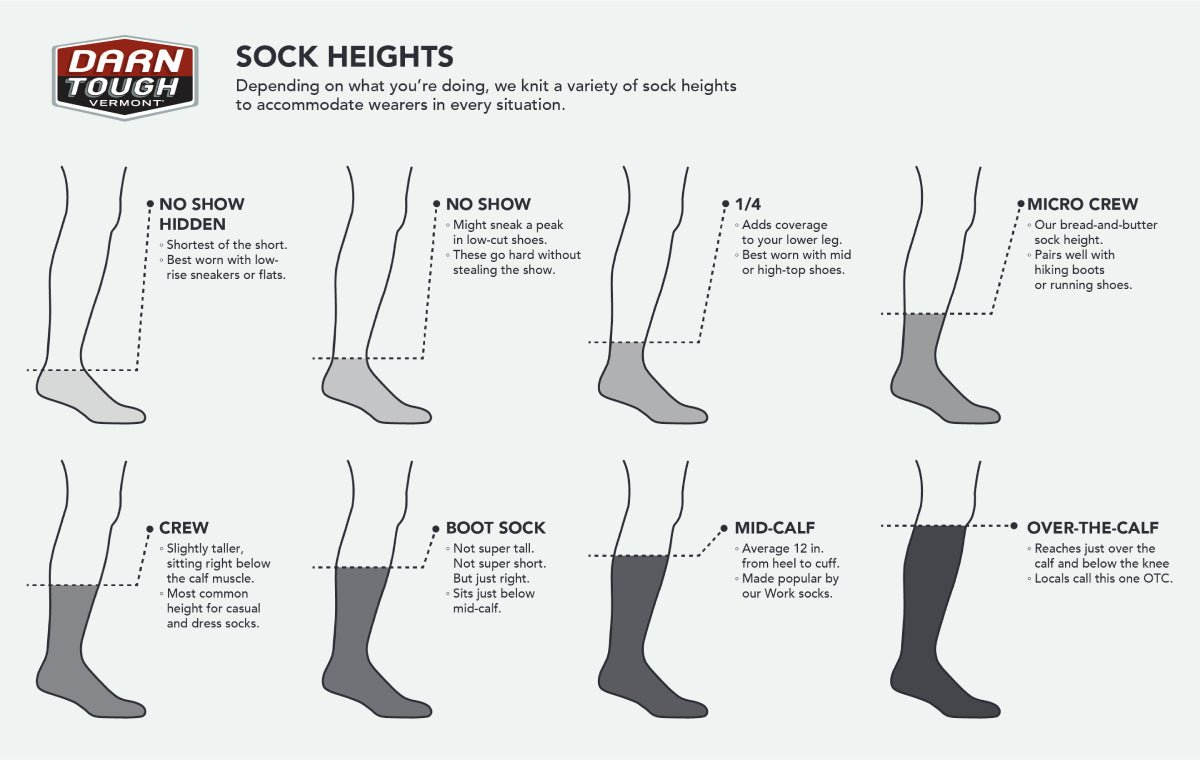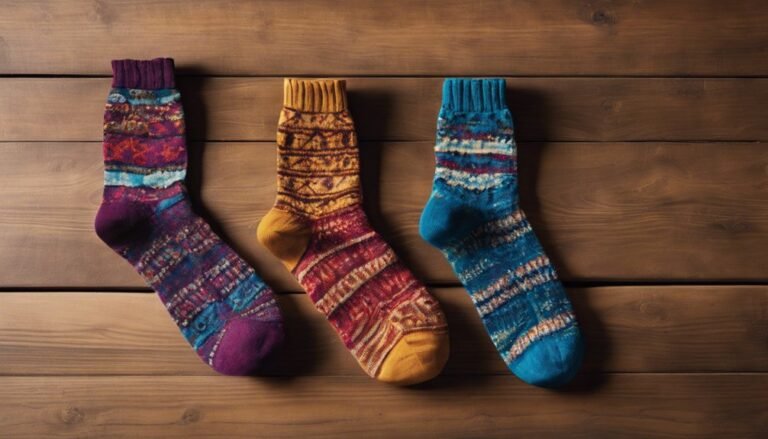Boot Socks Vs Crew Socks: Ultimate Guide to Comfort and Style
Boot socks and crew socks serve different purposes. Each has unique benefits.
Choosing the right sock can make a big difference in comfort and functionality. Boot socks are designed for durability and warmth, perfect for rugged terrains and cold weather. Crew socks, on the other hand, offer versatility and are ideal for everyday wear.
They provide a snug fit that works well with most shoe types. Understanding the differences between boot socks and crew socks can help you make the best choice for your needs. Whether you are hiking, working, or just going about your daily routine, the right sock can enhance your comfort and performance. Let’s explore what sets these two types of socks apart.

What Are Boot Socks?
Boot socks are essential for anyone who wears boots regularly. Designed to provide comfort and protection, these socks are thicker and more durable than regular socks. They come up higher on the leg to prevent chafing and blisters.
Made from materials like wool, cotton, or synthetic blends, boot socks offer added warmth. They are perfect for cold weather or long days on your feet. With boot socks, you get both comfort and functionality.
Features Of Boot Socks
Boot socks have several unique features. They are usually thicker than regular socks. This thickness offers extra cushioning and reduces foot fatigue.
Another feature is the height. Boot socks typically extend above the ankle, sometimes reaching the calf. This height prevents the boot from rubbing against your skin.
Material is another key feature. Boot socks are often made from wool or synthetic blends. These materials wick moisture away, keeping feet dry. Some boot socks also have reinforced heels and toes for added durability.
Benefits Of Wearing Boot Socks
Wearing boot socks offers many benefits. They provide extra cushioning, which reduces foot pain. This is especially important if you stand or walk a lot.
Boot socks also protect your feet from blisters. Their higher length prevents the boots from rubbing directly on your skin. This is crucial for long hikes or workdays.
Another benefit is warmth. Boot socks keep your feet warm in cold weather. They also wick away moisture, keeping your feet dry. Dry feet are less prone to blisters and infections.
In summary, boot socks are a must-have for boot wearers. They offer comfort, protection, and warmth. Choosing the right pair can make a big difference in your day.
What Are Crew Socks?
Crew socks are versatile, reaching mid-calf. They offer comfort and support. Boot socks, often thicker, extend higher for added warmth and protection in boots.
Crew socks are a popular sock style. They reach halfway up the calf, offering good coverage and comfort. These socks are versatile and work well with various types of shoes. Many people wear crew socks for everyday use, sports, and casual outings.Features Of Crew Socks
Crew socks come in different materials. Cotton is common for its breathability. Wool is used for warmth in colder months. Synthetic blends provide durability and moisture-wicking properties. Crew socks often feature ribbing at the top. This helps keep them in place throughout the day. They can be plain or have various patterns and designs.Benefits Of Wearing Crew Socks
Crew socks provide excellent support and comfort. The ribbed top keeps them from sliding down. They protect your feet from blisters and chafing. The material choices ensure your feet stay dry and comfortable. Crew socks are versatile. They can be worn with sneakers, boots, or dress shoes. They also come in various thicknesses for different weather conditions. This makes them suitable for both warm and cold climates. “`Material Differences
When choosing between boot socks and crew socks, the material plays a key role. Different materials offer unique benefits. This guide will help you understand the material differences.
Common Materials For Boot Socks
Boot socks often use wool. Wool provides warmth and moisture-wicking. It keeps feet dry and cozy.
Another common material is acrylic. Acrylic offers good insulation. It is also lightweight and durable.
Cotton blends are used too. Cotton is breathable and soft. It provides comfort for long wear.
Some boot socks include nylon. Nylon adds strength and stretch. This ensures a snug fit.
Common Materials For Crew Socks
Crew socks often use cotton. Cotton is soft and breathable. It feels comfortable on the skin.
Polyester is another material. Polyester is durable and quick-drying. It holds its shape well.
Many crew socks use spandex. Spandex offers elasticity. This ensures a good fit and flexibility.
Some crew socks use bamboo fibers. Bamboo is eco-friendly and soft. It also has natural anti-bacterial properties.

Design And Style
When choosing between boot socks and crew socks, design and style play a key role. Both types of socks have unique design elements that cater to different needs and preferences. Let’s explore these design elements in detail.
Design Elements Of Boot Socks
Boot socks are designed to provide comfort and support during long wear. They often feature:
- Thicker materials for warmth and cushioning.
- Higher cuffs to protect the ankles and lower legs.
- Reinforced heels and toes for durability.
- Compression zones for better fit and support.
These elements ensure boot socks can handle the rigors of hiking, working, or long walks. They offer extra warmth and cushioning, making them ideal for cold weather or rugged activities.
Design Elements Of Crew Socks
Crew socks are versatile and suitable for everyday wear. Their design includes:
- Mid-calf length for a snug fit around the calf.
- Lightweight materials for breathability and comfort.
- Simple patterns and colors for casual or formal wear.
- Elastic bands to keep the socks in place.
Crew socks are great for casual outings, office wear, or light exercise. Their lightweight design makes them comfortable for all-day wear, while their simple style ensures they match various outfits.
Comfort Factors
Choosing the right socks can make a significant difference in your daily comfort. Boot socks and crew socks both have unique comfort factors. Understanding these differences helps you make an informed choice.
Comfort In Boot Socks
Boot socks are designed to be worn with boots. They offer added cushioning and support for your feet. This is crucial when wearing heavy footwear.
Key features include:
- Thicker material: Provides warmth and extra padding.
- Extended length: Covers more of the leg, preventing chafing.
- Arch support: Reduces foot fatigue during long days.
- Moisture-wicking: Keeps feet dry, reducing the risk of blisters.
Boot socks are ideal for outdoor activities or work environments where boots are a necessity. The added cushioning ensures comfort throughout the day.
Comfort In Crew Socks
Crew socks are versatile and suitable for various footwear types. They usually reach mid-calf and provide a balance of comfort and practicality.
Key features include:
- Moderate thickness: Suitable for everyday wear without overheating.
- Elastic ribbing: Ensures a snug fit without slipping down.
- Breathable fabric: Keeps feet cool and comfortable.
- Cushioned sole: Offers comfort for daily activities.
Crew socks are perfect for casual wear, sports, or light work. They provide adequate support without the bulk of boot socks.
Durability And Maintenance
Choosing between boot socks and crew socks depends on their durability and maintenance. Both types of socks serve different purposes. Their longevity and care requirements vary. Let’s explore the durability and maintenance of both types.
Durability Of Boot Socks
Boot socks are designed for rugged use. They are thicker and often made from durable materials. These materials include wool, synthetic blends, and even reinforced fibers. Boot socks withstand harsh conditions. They offer excellent longevity, especially when used with boots. Their construction also provides extra cushioning. This helps in preventing wear and tear.
Durability Of Crew Socks
Crew socks are versatile and used daily. They are generally thinner compared to boot socks. Crew socks are made from cotton, polyester, and other blends. While they are comfortable, they may not last as long as boot socks. Frequent washing and daily wear can shorten their lifespan. The durability of crew socks varies with the brand and materials used.
Maintenance Tips
Proper maintenance can extend the life of both types of socks. For boot socks, wash them inside out. This prevents pilling and protects the fabric. Use cold water and gentle detergent. Avoid high heat when drying. High heat can damage the fibers.
Crew socks also benefit from careful washing. Use a laundry bag to prevent stretching. Wash in cold water. Avoid bleach as it can weaken the fabric. Dry on a low setting or air dry.
Choosing The Right Socks
Choosing the right socks can greatly impact your comfort and style. Whether you’re preparing for a long hike or a casual day, knowing the differences between boot socks and crew socks is essential.
Factors To Consider
When selecting socks, consider the material. Wool and synthetic blends keep feet warm and dry. Cotton is breathable but not ideal for heavy activity.
Think about the length. Boot socks are taller and offer more coverage. Crew socks end below the calf and are more versatile for daily wear.
Comfort matters too. Boot socks often have extra padding. Crew socks usually have a snug fit.
Best Uses For Boot Socks
Boot socks are perfect for hiking and outdoor activities. They provide extra cushioning and warmth. These socks also work well with work boots. They reduce friction and prevent blisters.
During winter, boot socks keep your feet cozy. They are ideal for cold weather conditions. These socks are also great for long walks in the snow.
Best Uses For Crew Socks
Crew socks are versatile for everyday wear. They pair well with sneakers and casual shoes. These socks are good for light exercise and daily activities.
In warmer weather, crew socks keep feet cool. They are less bulky than boot socks. Crew socks are also easy to find in various colors and patterns.

Frequently Asked Questions
Are Boot Socks And Crew Socks The Same?
No, boot socks and crew socks are not the same. Boot socks are longer and thicker, ideal for boots. Crew socks are shorter and versatile, suitable for various footwear.
What Is The Point Of Boot Socks?
Boot socks provide extra cushioning and warmth. They enhance comfort, prevent blisters, and offer better support.
Why Does Gen Z Not Like Ankle Socks?
Gen Z dislikes ankle socks due to their preference for fashion-forward, visible socks. They favor statement socks for self-expression and trends.
Should You Wear Crew Socks With Boots?
Yes, you should wear crew socks with boots. They provide comfort, prevent blisters, and offer better support.
Conclusion
Choosing between boot socks and crew socks depends on your needs. Boot socks offer extra warmth and protection. Ideal for colder climates and rugged activities. Crew socks provide versatility and comfort for daily wear. Both types have unique benefits. Consider your lifestyle and preferences.
Always prioritize comfort and functionality. Happy sock shopping!







